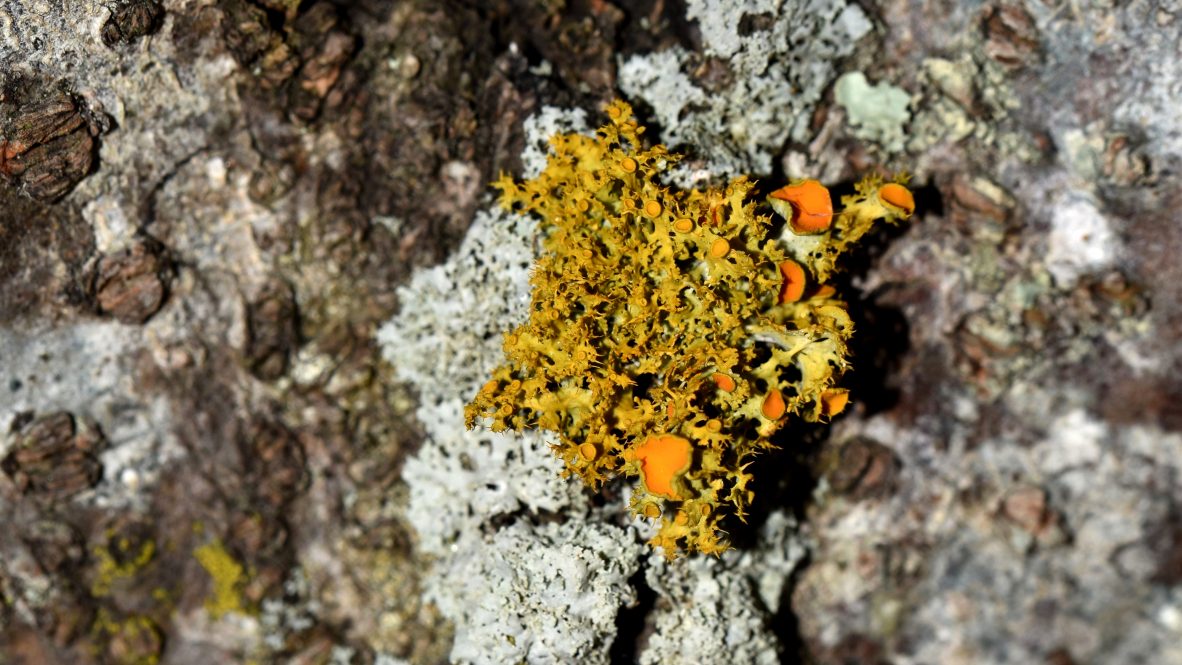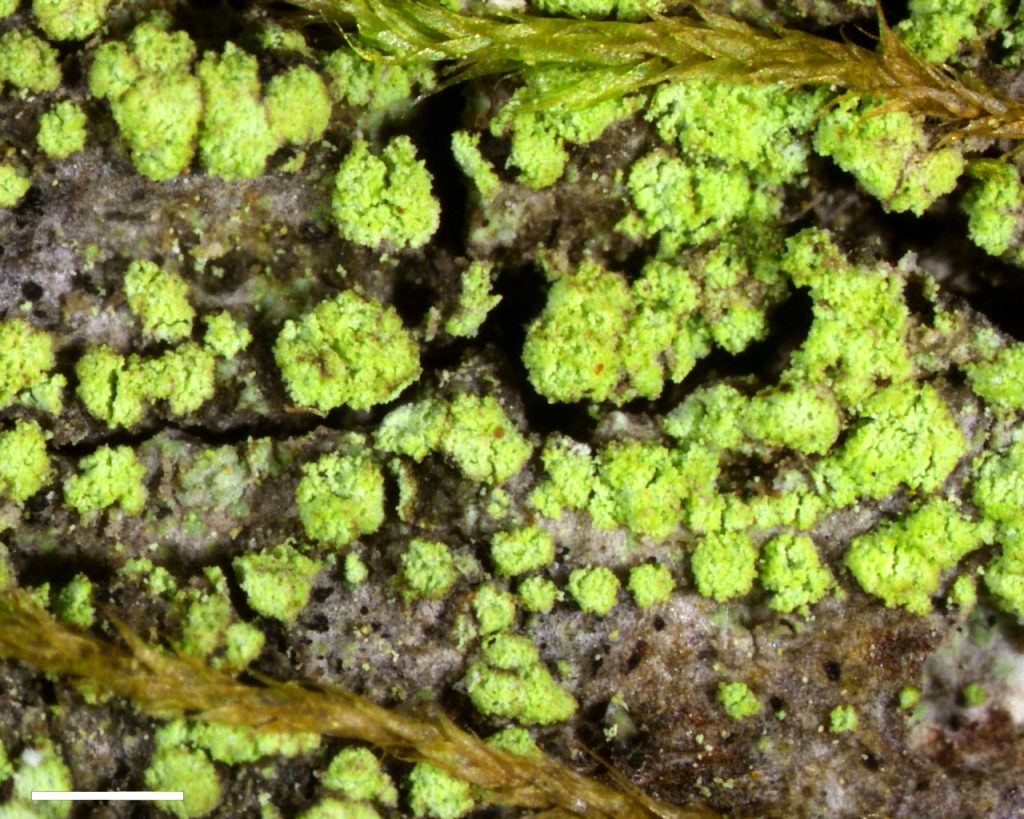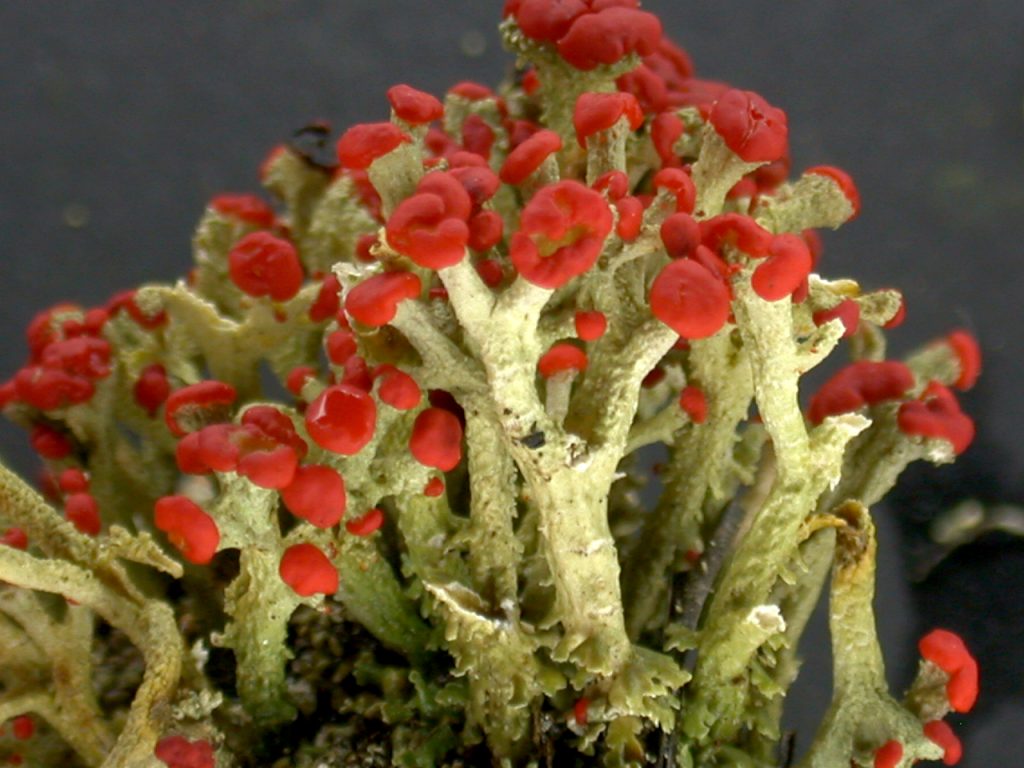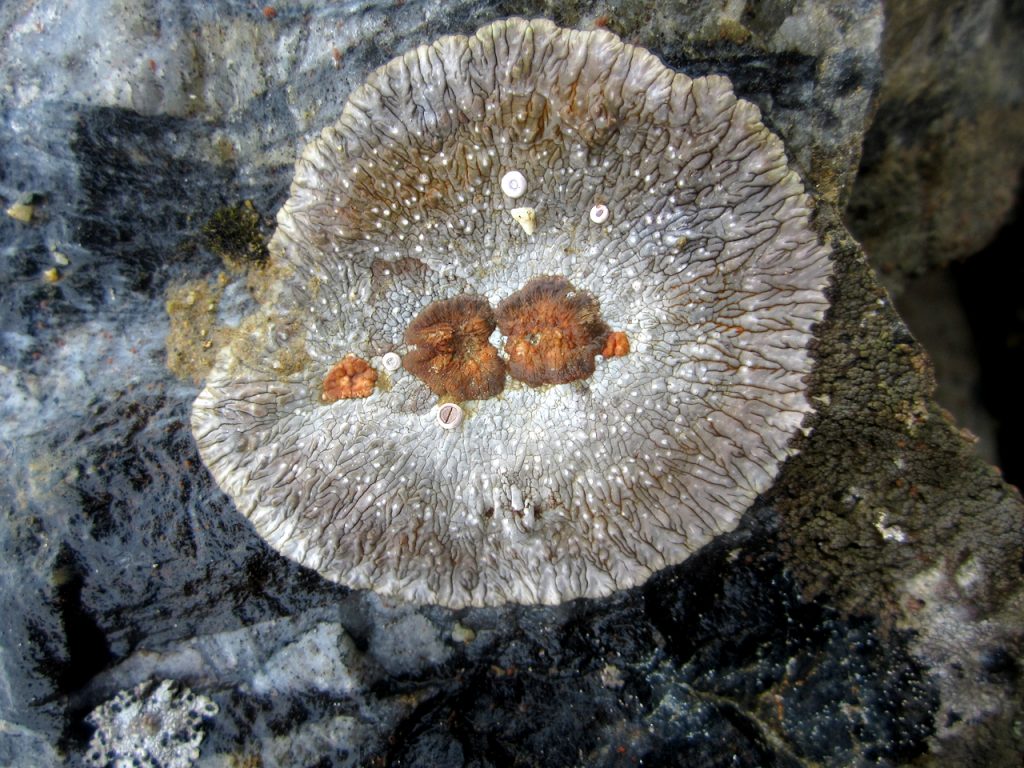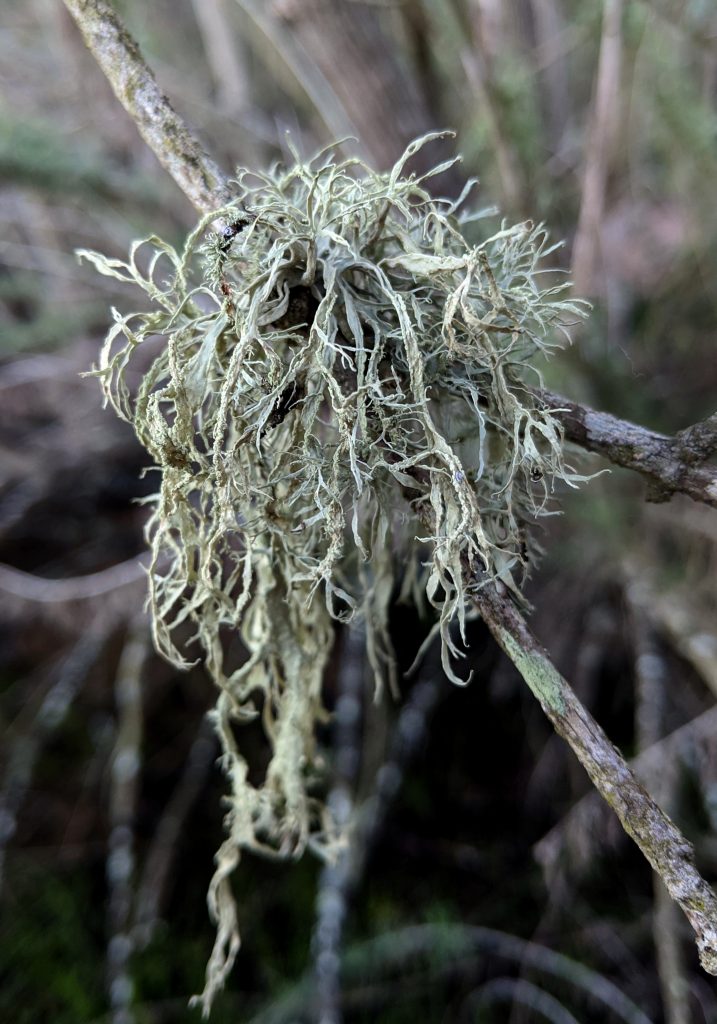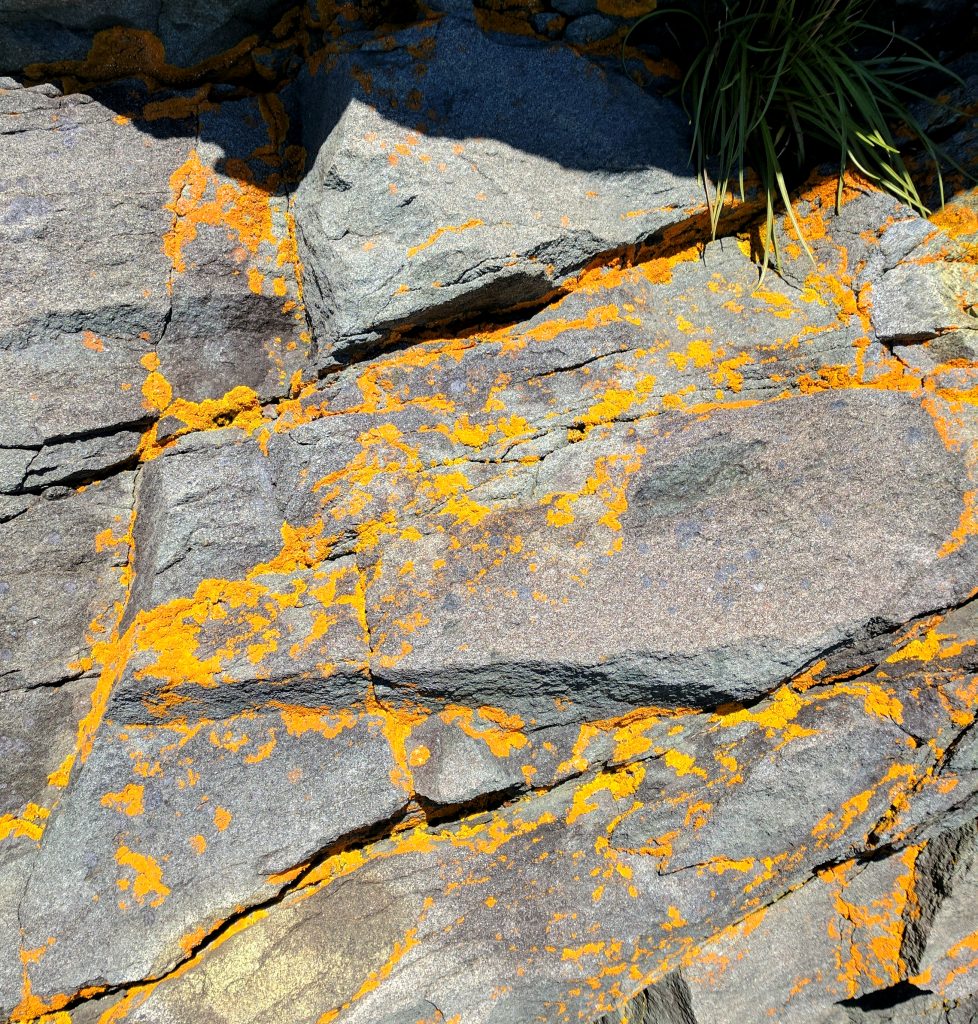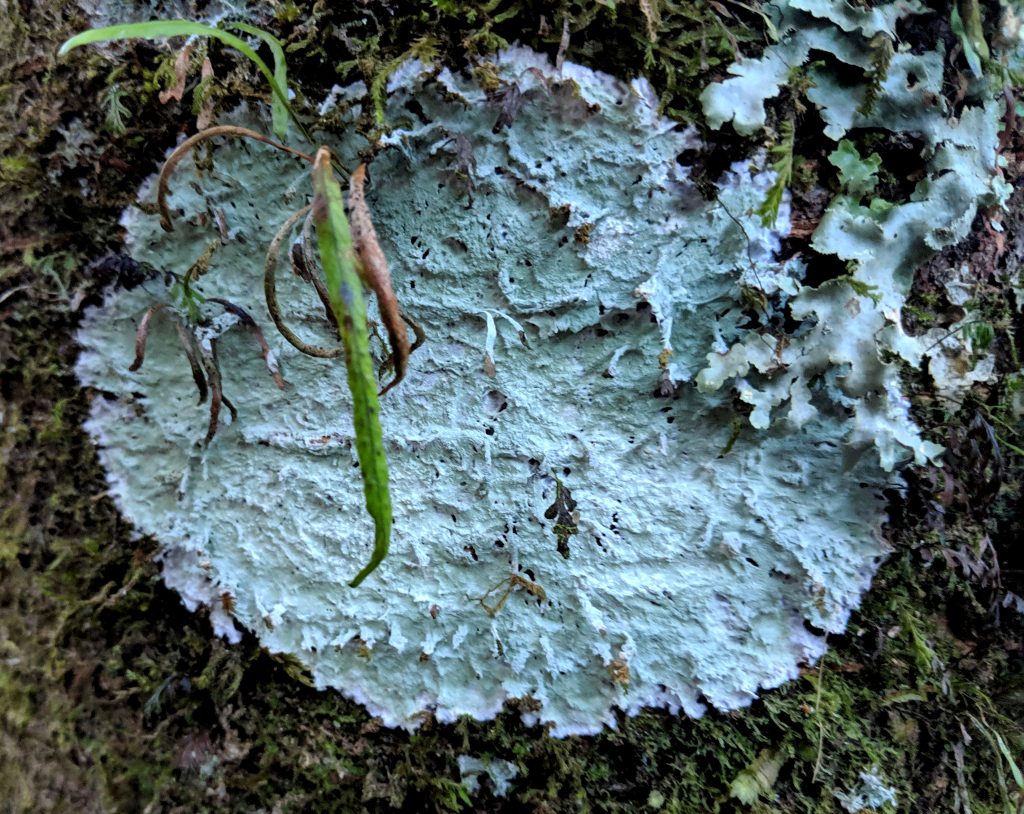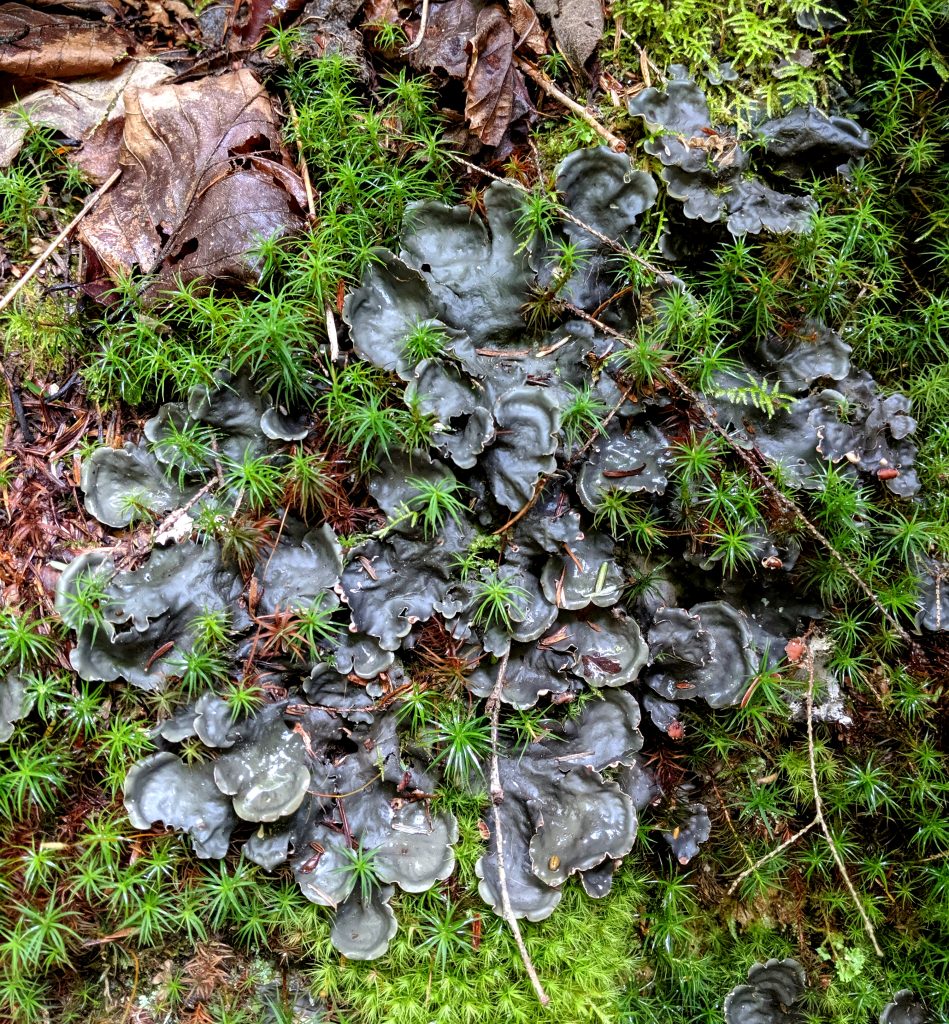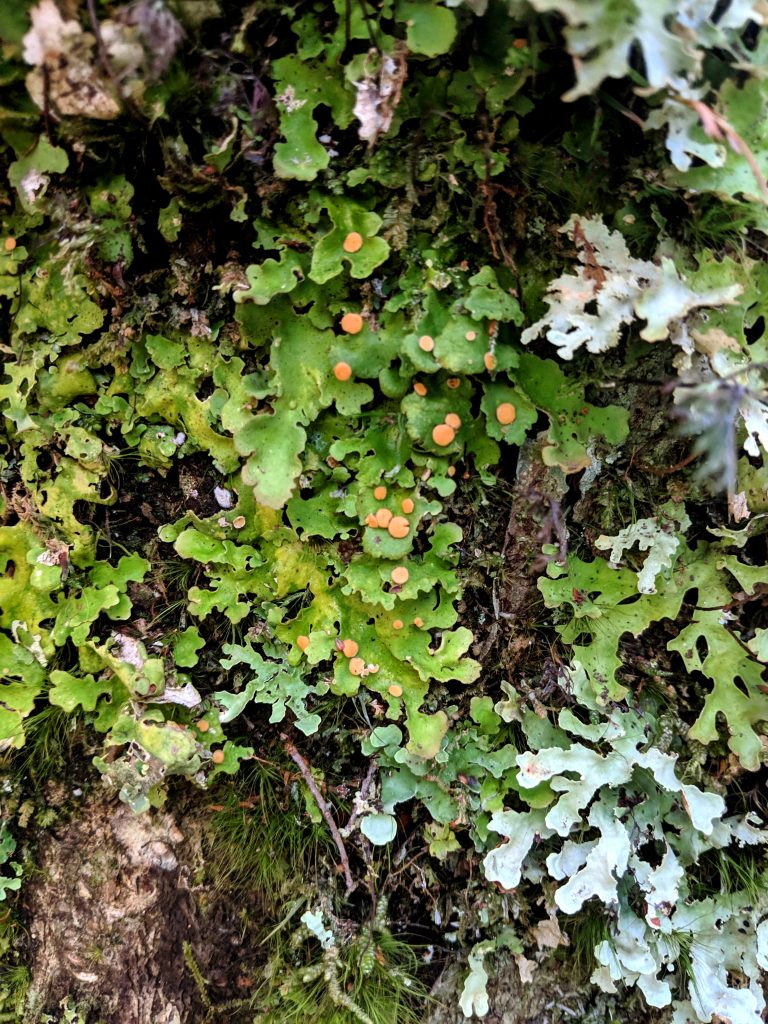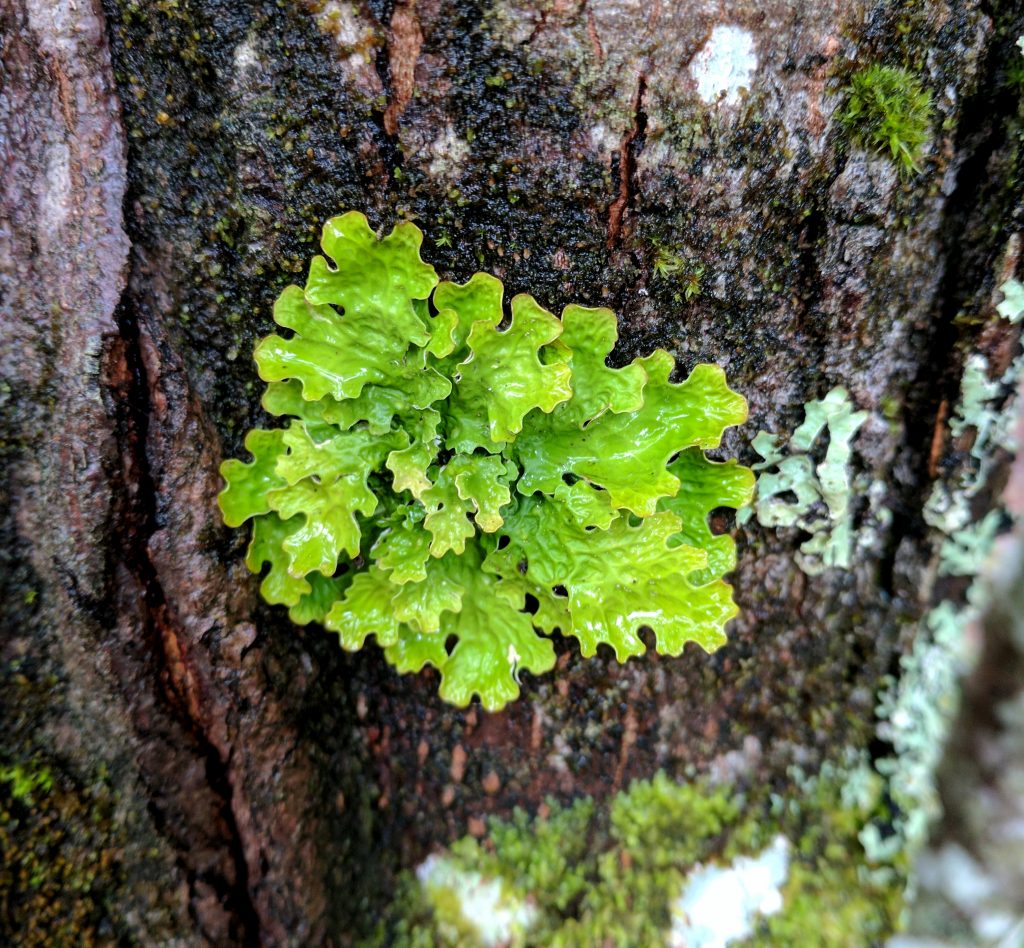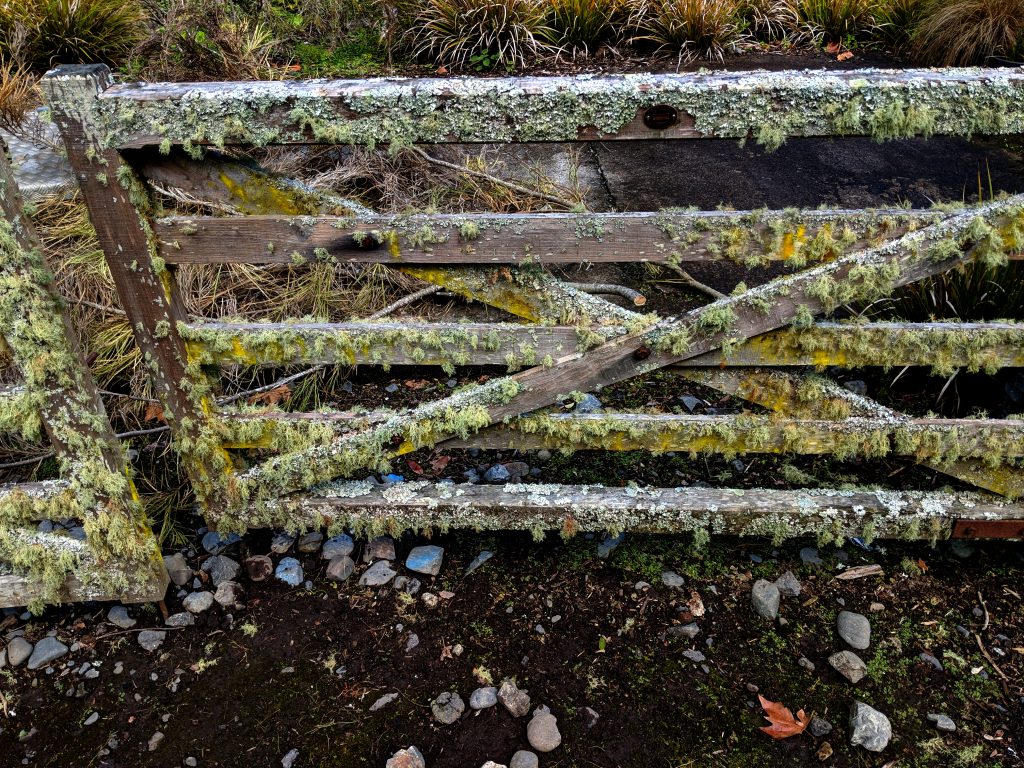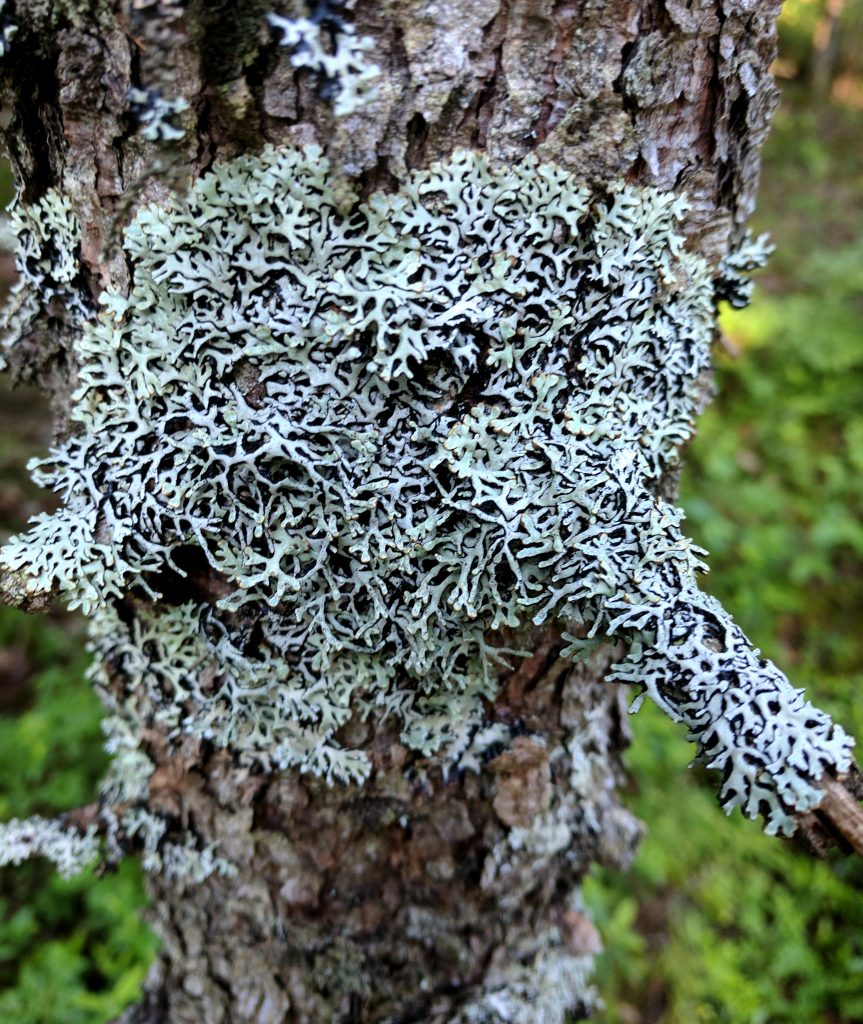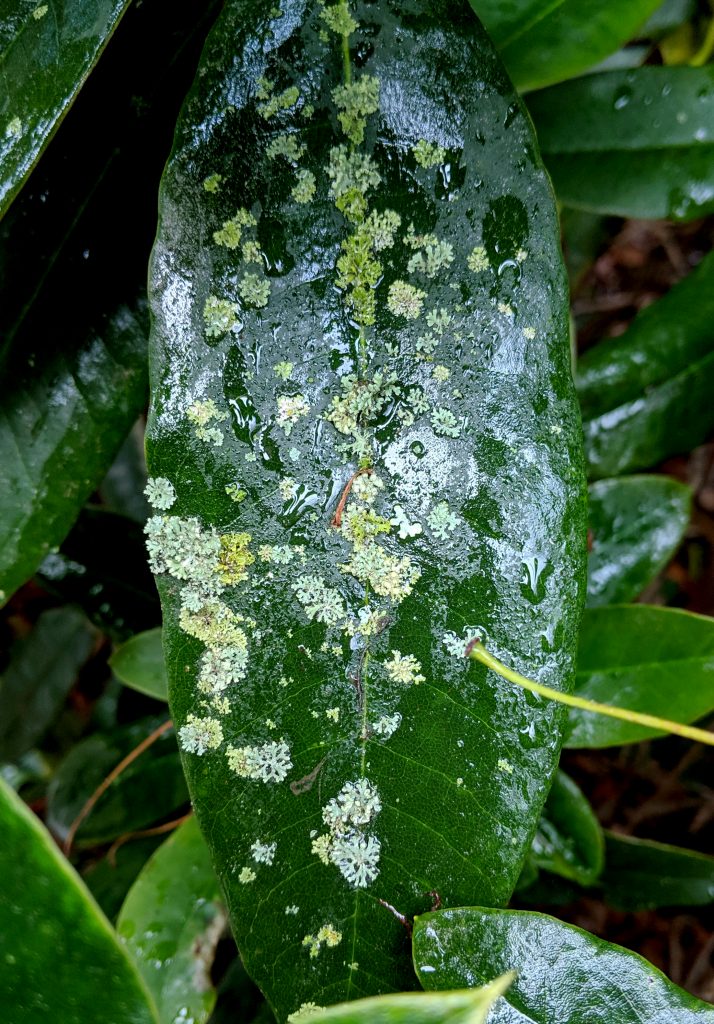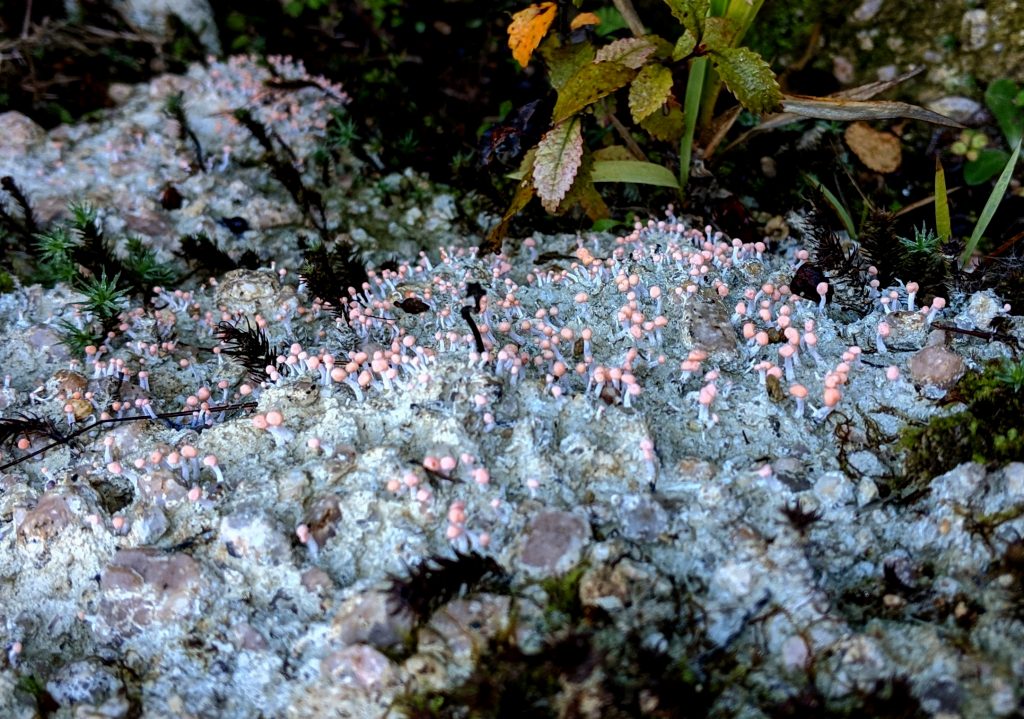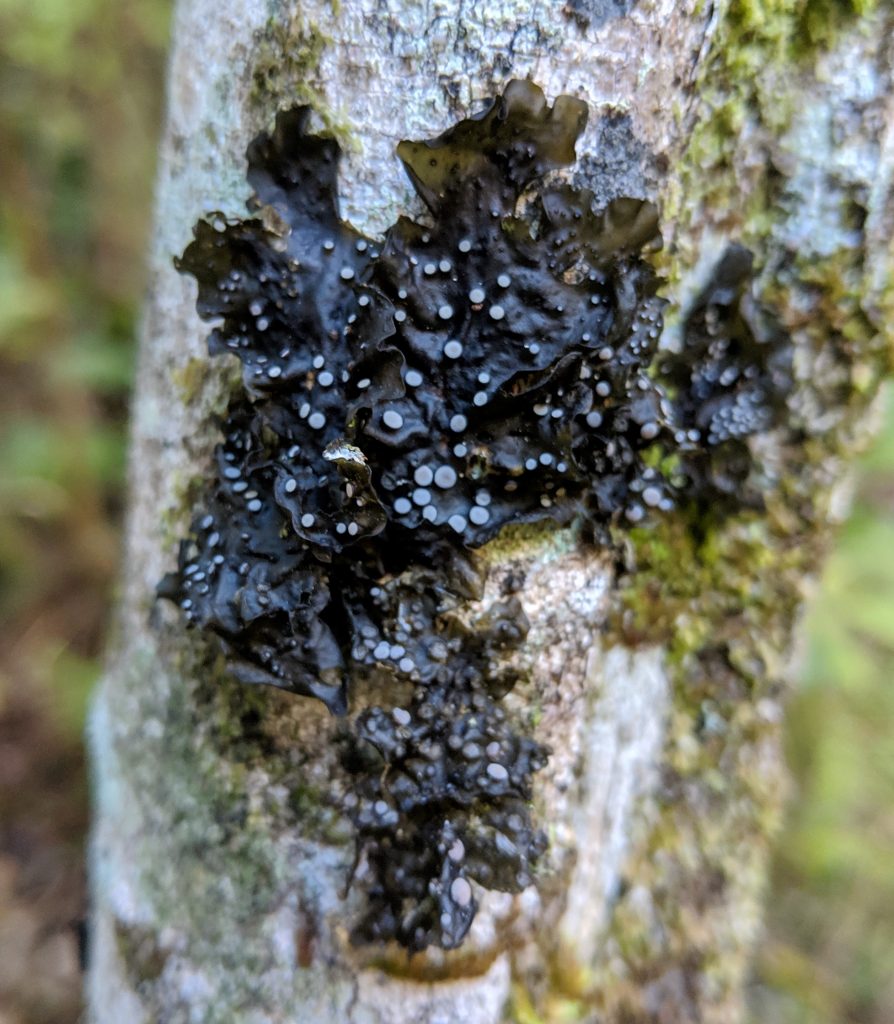Situated next to a well-traveled walkway on Storrs campus resides something that has not been spotted in Connecticut in over 100 years. Chances are good that you have passed them regularly and did not notice the startling specimens of Teloschistes chrysophthalmus or the ‘Golden-eye lichen’, a vibrant assemblage of a fungus and algae seemingly hiding in plain sight. The finding has been documented in a paper published in The Bryologist, it has sparked an unexpected conservation project, and serves as an excellent example of how discoveries are all around us.
The bright orange lichens were spotted by co-author Henry Frye, a doctoral student and botanist who, with the absence of flowering plants to explore in the depths of winter decided to learn more about lichens, which are present year-round. He checked out a book from the UConn library and set about exploring what the splotches on the trees and rocks were.
Frye soon came across some striking specimens living on some trees that had been planted on campus around 15 years ago. On a hunch that the brilliant splotches in question could be something rare, Frye emailed resident lichen experts and co-authors Professor Bernard Goffinet and doctoral student Zachary Muscavitch.
“This might have been maybe my second or third lichen that I was trying to identify, so I reached out to double check,” says Frye.
Goffinet and Muscavitch confirmed the hunch, “It turned out that it was a golden-eye,” says Frye. “It's funny you could find something like that just on campus, right by the sidewalk where thousands of people just pass right by each day.”
“It's bright gold, it sort of jumps right out and there aren't a whole lot of things that color on campus,” says Muscavitch who points out that despite the showy coloration of the golden-eye, lichens are generally overlooked and people seldom notice them.
This lack of lichen awareness could be due to the perception that lichens are unimportant, static and unintriguing “organisms”, says Goffinet,
“These organisms are transparent to most people; most people don't see them. This highlights a level of diversity that we are not even aware of.”
Though unnoticed, Goffinet explains lichens play integral roles within the ecosystem such as providing biomass and through cycling nutrients through the system to contributing to soil development. They are also important indicators about the health of an ecosystem since they depend on the air for nutrients and moisture. Factors such as air pollution and acid rain have led to lichen declines, along with habitat destruction and development. Lichens are also extremely slow growing, which can hamper efforts to study them.
“The golden-eye lichen used to be found throughout New England, the last time it was documented in Connecticut was 1911,” says Frye. “We think they declined because of pollution and disturbances, like hurricanes. Their decline was likely a mix of human and natural factors and likely several others.”
In the paper, the researchers make the case that finding the lichen again on campus is the result of re-introduction. The golden-eye is found growing on four of the same species of non-native tree planted at the same time. With it grow other species not previously known from the state, suggesting that their cooccurrence on the same trees is unlikely explained by chance immigration alone.
Furthermore, “The lichen is an association between an alga and a fungus. There are at least two members and for the lichen to appear elsewhere, both members need to disperse, and they can disperse together or not. They have potential to disperse via the wind or via multiple vectors,” says Goffinet. “Wherever they land doesn't necessarily mean they will grow there. To find several Teloschistes lichens on campus begged the question how did they make it back to Connecticut? They all grow on a non-indigenous tree species, and their presence here is best explained by forced or human-assisted dispersal. These nursery trees were planted 15 years ago and so these lichens survived for this period, suggesting that the conditions have been right, at least good enough for survival.”
Frye points out another important aspect of this discovery – though environmental conditions are favorable enough for the lichens to call campus home again, the trees the lichens are slowly growing on are quickly dying,
“The trees are not doing well; the soil is compacted and salting sidewalks resulted in damage to the trees. The most likely solution is cutting trees down because they're on their last legs. We were looking at transplanting the lichens to see how that would work and we could evaluate different ways to do that. It has turned into a small conservation project at this point. Right now, we're discussing where to move them.”
The find sparked an important debate for the team to mull over; should Teloschistes be conserved since although it was once native, it was accidentally re-introduced here? What about the other species found on the trees that are non-native, and hence introductions? What deserves to be conserved?
Conservation questions aside, Frye’s finding highlights that there are wonders all around us, says Goffinet,
“There are things to be discovered in your backyard, you don’t have to go far. This is a prominent place on campus, yet it took 15 years after the trees were planted before someone noticed.”
The authors hope that the finding will spark curiosity and appreciation for lichens. Muscavitch adds that within the field of lichenology new discoveries are made by experts and non-experts alike and there is much to be learned,
“In some ways it is good that the field of lichenology is not saturated. There have been a tremendous amount of lichen discoveries made by hobbyists. It is great that the public can participate. People are describing more species every day. There are fewer researchers but so many more things to do.”
Lichens adorn surfaces all around us and once you know what you are looking for, you will see them everywhere says Muscavitch. From metal road signs, sidewalks, trees, or tombstones, lichens grow on and into all kinds of surfaces. Lichens are important to a wide range of animals, for instance hummingbirds who carefully weave them into their nests, presumably to help camouflage, and the same can be seen with some moths that spin cocoons that incorporate lichens. In some areas of the world, lichens are a diet staple, for instance they are the main source of food for caribou. Humans also enjoy lichen, fermented and served in salads or fermented and used as dyes. To learn more about these constant companions in our landscape, join Muscavitch on an upcoming tour On the Lookout for Lichens on May 8th at Wolf Rock Preserve on Crane Hill Road (Mansfield. Space is limited. Please register at https://joshuastrust.org/lichens-registration/. Note that rain cancels, no dogs, and mask up, please.
